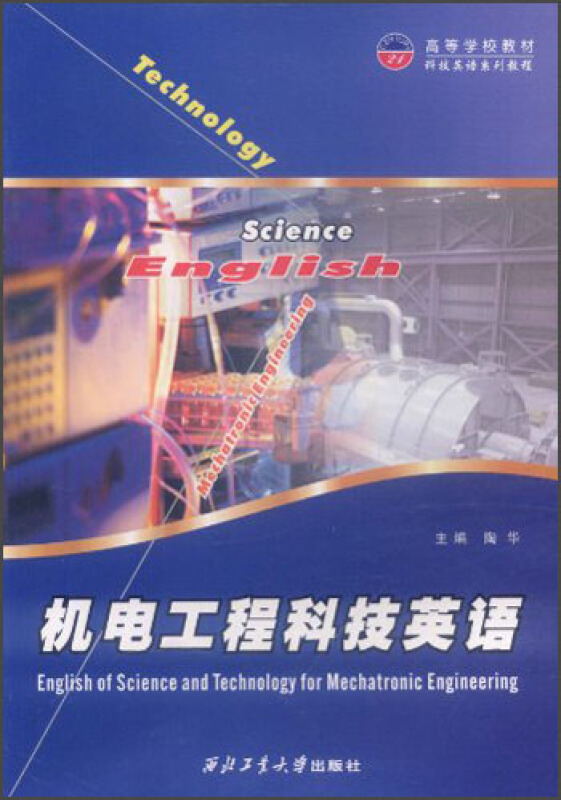- ISBN:9787561222836
- 装帧:暂无
- 册数:暂无
- 重量:暂无
- 开本:16开
- 页数:301页
- 出版时间:2007-08-01
- 条形码:9787561222836 ; 978-7-5612-2283-6
内容简介
《高等学校教材科技英语系列教程:机电工程科技英语》以机电工程领域的英语文献为教学内容,全书包括:工程材料、金属成形、机械零件、计算机应用、工业设计、数控加工、计算机集成制造、特种加工、机电学与测量系统、汽车、飞机设计、飞机制造、微机电系统、机器人、工业工程等17个单元的教学内容,另外还包括了科技英语翻译、科技英语写作等科技英语技能拓展辅助教学内容。《高等学校教材科技英语系列教程:机电工程科技英语》旨在提高学生的专业英语快速阅读理解能力,同时希望能锻炼英文写作能力。《高等学校教材科技英语系列教程:机电工程科技英语》适合于理工科大专院校机械工程或机电工程专业的学生学习使用,也可供专业技术人员阅读。
目录
Text 1 Type of Materials
Text 2 Steel
Text 3 Polymer
Text 4 Mechanical Properties of Material
Free Reading
Exercise
Unit 2 Material Forming
Text 1 Metal Forming
Text 2 sheet Forming
Text 3 Forging
Text 4 Injection Molding
Free Reading
Exercise
Unit 3 Mechanical Components
Text 1 Basic Machines and Machine Components
Text 2 Rolling Element Bearings
Text 3 Flexible Mechanical Elements
Text 4 Gear
Free Reading
Exercise
Unit 4 Computer Applications Ⅰ
Text 1 Computers: Getting Started
Text 2 Computer Aided Design
Text 3 Computer Aided Engineering
Text 4 Introduction to New DMU Technology
Free Reading
Exercise
Unit 5 Computer Applications Ⅱ
Text 1 Computer Aided Process Planning
Text 2 Computer Aided Manufacturing
Text 3 Computer Aided Quality Control
Text 4 Agile Manufacturing and Green Product Manufacturing
Free Reading
Exercise
Unit 6 Introduction to Industrial Design
Text 1 What Is Industrial Design?
Text 2 Fundamental Entry-Level Requirements for Industrial Designers
Text 3 Design and Culture
Text 4 Ergonomics
Text 5 Green Design
Free Reading
Exercise
Unit 7 Practice of Industrial Design
Text 1 Organic Geometry Ⅰ
Text 2 Organic Geometry Ⅱ
Text 3 CAD vs. CAID
Text 4 Studio Tools 10——Computer Aided Industrial Design
Free Reading
Exercise
Unit 8 CNC Machines
Text I The Fundamentals of CNC
Text 2 How CNC Works
Text 3 Structures of CNC Machines
Text 4 Types of CNC Machines
Free Reading
Exercise
Unit 9 Computer-Integrated Manufacturing
Text 1 Activities for Manufacturing Systems
Text 2 Flexible Manufacturing Systems
Text 3 Computer-Integrated Manufacturing Technology
Exercise
Unit 10 Non-Conventional Machine
Text 1 Electrical Machining Processes
Text 2 Development Trends of Erosion Machining
Text 3 Application Areas of RP&M
Free Reading
Exercise
Unit 11 Meehatronies and Measurement Systems
Text 1 Mechatronics
Text 2 Measurement Systems
Text 3 Measurement System Response
Text 4 Sensors for Mechanical Measurements
Text 5 Temperature Measurement
Free Reading
Exercise
Unit 12 Automobile
Text 1 Fundamentals of Automobile
Text 2 How an Energy Works
Text 3 Transmission
Text 4 Suspension and Steering Systems Operation
Free Reading
Exercise
Unit 13 Aircraft Design
Text 1 Phases of Aircraft Design
Text 2 Aircraft Conceptual Design
Text 3 Loads on Aircraft Structural Components
Text 4 Function of Structural Components
Free Reading
Exercise
Unit 14 Aircraft Fabrication
Text 1 Fabrication of Structural Components
Text 2 A Flexible Development System for Automated Aircraft Assembly
Text 3 A New Look at Aircraft Assembly——Friction Stir Welding Is the Answer
Text 4 Verifying Aircraft Assembly with Real-Time Digital hotogrammetry
Exercise
Unit 15 MEMS
Text 1 Introduction to MEMS
Text 2 Mechanical to Electrical Transduction
Text 3 MEMS Actuators
Text 4 Trends in MEMS Technology
Exercise
Unit 16 Robotics
Text 1 Robotics
Text 2 Industrial Robots
Text 3 Component of a Robot System
Text 4 Robotic Sensors
Free Reading
Exercise
Unit 17 Industry Engineering
Text 1 Industrial Engineering Education for the 21st Century
Text 2 Real IE Value
Text 3 Operations Research
Text 4 Total Quality Management
Exercise
Development Skills for Technical English
一、科技英语翻译基础
二、复合句的分析方法
三、长难句的译法
四、科技英文写作
Appendix
1 A List of Common British and American Spelling Equivalents
2 A List of Common Prefixes and Suffixes
Bibliography
节选
Mechanical properties mean a material's ability to carry or resist the application of mechanical forces and loads.The material's reaction to these forces is usually either deformation or fracture.Mechanical properties are probably the most important to manufacturing processing.They determine the extent to which a material may be formed, sheared, or machined.Typical forces which are applied to a material are tension, compression, shear, and torsion, these forces are used to form and shape materials. Furthermore, materials must withstand excess amounts of these forces in product applications. Since screws are used to assemble wood parts," they must absorb torsion forces. Rods holding suspended fixtures must withstand excess tension forces.The head of a hammer must absorb compression forces.(1) Stress-strain. The stress-strain relationship is often used to study many mechanical properties. Stress is force applied to material. It is usually measured in either pounds per square inch or kilograms per square centimeter. Strain is the change in the length of a material which is under stress. The strain measurements are given in term of the amount of elongation of the material per unit of length. Strain is given in thousandths of an inch per inch of material of millimeters (of smaller units) per centimeter of material. For most materials, the elongation of a material under stress is quite small. ……
-

我有所念人,隔在远远乡
¥17.9¥49.8 -

了不起的盖茨比(纯英文)/床头灯英语.3000词读物
¥5.5¥12.8 -

茶花女
¥5.2¥12.0 -

地心游记(纯英文)/床头灯英语.3000词读物
¥6.2¥15.8 -

巴黎圣母院
¥5.6¥15.5 -

命案目睹记
¥13.2¥33.8 -

THE LITTLE PRINCE-小王子
¥6.3¥19.8 -

小妇人(纯英文)/床头灯英语.3000词读物
¥6.4¥15.8 -

视听说教程2学生用书
¥17.6¥45.0 -

考研英语背单词20个词根词缀
¥2.2¥3.2 -

了不起的盖茨比:经典全译本
¥8.5¥25.0 -

英语学习-大家小书
¥14.7¥36.0 -

理想丈夫
¥13.8¥28.0 -

MADAME BOVARY-包法利夫人
¥10.9¥36.8 -

THE GREAT GATSBY-了不起的盖茨比
¥6.0¥16.8 -

流浪地球刘慈欣
¥18.0¥62.0 -

浮生六记(汉英对照)
¥18.9¥65.0 -

赖世雄美语音标(美语从头学)
¥16.5¥25.0 -

名著名译英汉对照读本马克.吐温短篇小说选
¥10.5¥28.0 -

汤姆叔叔的小屋
¥13.7¥35.0













